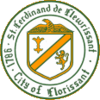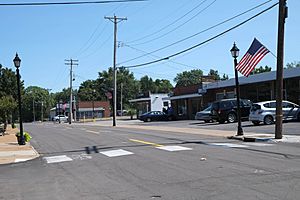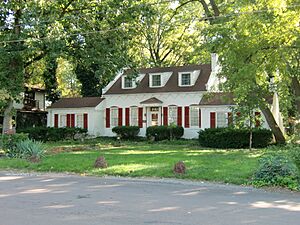Florissant, Missouri facts for kids
Quick facts for kids
Florissant, Missouri
|
|||
|---|---|---|---|
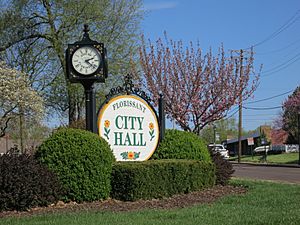
Florissant City Hall sign, April 2013
|
|||
|
|||
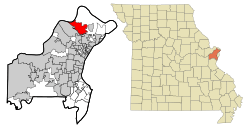
Location of Florissant, Missouri
|
|||
| Country | United States | ||
| State | Missouri | ||
| County | St. Louis | ||
| Founded | 1785 | ||
| Area | |||
| • Total | 12.86 sq mi (33.31 km2) | ||
| • Land | 12.55 sq mi (32.51 km2) | ||
| • Water | 0.31 sq mi (0.80 km2) | ||
| Elevation | 528 ft (161 m) | ||
| Population
(2020)
|
|||
| • Total | 52,533 | ||
| • Density | 4,085.0/sq mi (1,577.09/km2) | ||
| Time zone | UTC-6 (Central (CST)) | ||
| • Summer (DST) | UTC-5 (CDT) | ||
| ZIP Codes |
63031, 63032, 63033, 63034
|
||
| Area code(s) | 314 | ||
| FIPS code | 29-24778 | ||
| GNIS feature ID | 2394777 | ||
Florissant (pronounced like FLOR-iss-ant) is a city in St. Louis County, Missouri. It's part of the larger Greater St. Louis area. Florissant is a suburb located just north of St. Louis. In 2020, about 52,533 people lived there, making it the largest city in St. Louis County.
Contents
History of Florissant
The exact date Florissant was first settled is not known. However, it is one of the oldest settlements in Missouri. Some historians think it was settled around the same time as St. Louis. The first local government was set up in 1786. Records from 1787 show that 40 people lived in Florissant and there were seven farms.
Early French and Spanish Influence
French settlers called the village "Fleurissant," which means "Blooming." Spanish rulers called it "St. Ferdinand." It was a typical French village with shared lands for farming. The village was often called after its main church, St. Ferdinand. The original church, the Old St. Ferdinand Shrine, is still there today. It is listed on the National Register of Historic Places.
Around 1809, the Cold Water Cemetery had its first burial. This cemetery is also listed on the National Register of Historic Places because of its important history.
Growth and Changes Over Time
Even in 1889, most people in Florissant spoke French. The first train line came to the area in 1878. It was an extension of a line from St. Louis City. The last train to Florissant ran on November 14, 1931.
After World War II, Florissant changed a lot. It grew from a small village into a big suburban area. Builders started building many new homes on what used to be farmland. Between 1947 and 1980, about 18,000 houses were built. The population grew to its highest point of about 76,000 people in the mid-1970s. This made Florissant the biggest city in St. Louis County.
Long-Serving Mayor James Eagan
James J. Eagan was the first mayor of Florissant after a new rule created the position. He served for 37 years, from 1963 until he passed away in 2000. He was re-elected nine times and became one of the longest-serving mayors in the United States. The James J. Eagan Community Center is named after him.
In 2012, Money magazine named Florissant one of the top 100 Best Places to Live. In 2014, it was ranked the best small city in America for retirement. It was also named the second-safest city in Missouri.
Florissant Old Town Historic District
The Florissant Old Town Historic District is a special area created in 1969 to protect its history. The main part of Old Town Florissant is listed on the National Register of Historic Places. This area includes streets like St. Francois, St. Ferdinand, St. Denis, and Lafayette.
This historic area has about 124 important buildings built between 1790 and 1940. The historic Old St. Ferdinand Shrine is at the west end of Old Town. The Shrine has four old buildings still in their original spots:
- The 1819 convent
- The 1821 church
- The 1840 rectory
- The 1888 schoolhouse
The local historical society, Historic Florissant, works out of the Gittemeier House. This house has been kept in good condition.
Geography of Florissant
Florissant covers a total area of about 12.87 square miles (33.31 square kilometers). Most of this area is land, about 12.56 square miles (32.51 square kilometers). The rest, about 0.31 square miles (0.80 square kilometers), is covered by water.
Population and Demographics
Florissant's population has changed over the years. Here's how it has grown:
| Historical population | |||
|---|---|---|---|
| Census | Pop. | %± | |
| 1880 | 817 | — | |
| 1890 | 769 | −5.9% | |
| 1900 | 752 | −2.2% | |
| 1910 | 765 | 1.7% | |
| 1920 | 682 | −10.8% | |
| 1930 | 1,039 | 52.3% | |
| 1940 | 1,369 | 31.8% | |
| 1950 | 3,737 | 173.0% | |
| 1960 | 38,166 | 921.3% | |
| 1970 | 65,908 | 72.7% | |
| 1980 | 55,372 | −16.0% | |
| 1990 | 51,206 | −7.5% | |
| 2000 | 50,497 | −1.4% | |
| 2010 | 52,158 | 3.3% | |
| 2020 | 52,533 | 0.7% | |
| 2020 | |||
Racial and Ethnic Makeup
The table below shows the different racial and ethnic groups in Florissant. The US Census counts Hispanic/Latino people as an ethnic group, so they can be of any race.
| Race / Ethnicity (NH = Non-Hispanic) | Pop 2000 | Pop 2010 | Pop 2020 | % 2000 | % 2010 | % 2020 |
|---|---|---|---|---|---|---|
| White alone (NH) | 42,807 | 35,559 | 23,980 | 84.77% | 68.18% | 45.65% |
| Black or African American alone (NH) | 5,775 | 13,889 | 23,377 | 11.44% | 26.63% | 44.50% |
| Native American or Alaska Native alone (NH) | 90 | 109 | 94 | 0.18% | 0.21% | 0.18% |
| Asian alone (NH) | 302 | 394 | 519 | 0.60% | 0.76% | 0.99% |
| Pacific Islander alone (NH) | 15 | 19 | 12 | 0.03% | 0.04% | 0.02% |
| Other race alone (NH) | 79 | 81 | 347 | 0.16% | 0.16% | 0.66% |
| Mixed race or Multiracial (NH) | 676 | 1,078 | 2,642 | 1.34% | 2.07% | 5.03% |
| Hispanic or Latino (any race) | 753 | 1,029 | 1,562 | 1.49% | 1.97% | 2.97% |
| Total | 50,497 | 52,158 | 52,533 | 100.00% | 100.00% | 100.00% |
2020 Census Details
The 2020 United States census counted 52,533 people in Florissant. There were 19,702 households and 12,336 families. The population density was about 4,186 people per square mile.
- About 46.34% of the people were white.
- About 44.79% were Black or African-American.
- About 2.7% of the population was Hispanic or Latino.
Of the households, 26.1% had children under 18. About 39.3% were married couples living together. The average household had 2.6 people. The average family had 3.2 people.
About 23.1% of the population was under 18 years old. The median age was 36.9 years. This means half the people were younger than 36.9 and half were older.
The average household income from 2016-2020 was about $58,769. About 10.2% of the population lived below the poverty line. This included 17.2% of those under 18.
2010 Census Details
In the 2010 census, there were 52,158 people living in Florissant. There were 21,247 households. The population density was about 4,153 people per square mile.
- About 58.3% of the people were White.
- About 36.8% were African American.
- About 2.0% of the population was Hispanic or Latino.
About 32.3% of households had children under 18. About 42.4% were married couples. The average household size was 2.42 people. The average family size was 3.00 people.
The median age in 2010 was 38 years. About 23.9% of residents were under 18. About 15.5% were 65 years or older.
Education in Florissant
Florissant has many schools for students of all ages.
Public Schools
Florissant is served by two public school districts:
- Hazelwood School District
- Ferguson-Florissant School District
High schools in Florissant include:
- McCluer North High School (Ferguson-Florissant School District)
- McCluer High School (Ferguson-Florissant School District)
- North Technical High School
- Hazelwood Central High School (Hazelwood School District)
There are also several middle and elementary schools within the city limits.
Private Schools
- North County Christian School is a private Christian school for students from pre-school to 12th grade.
- There are also several Catholic schools for kindergarten through 8th grade, such as Sacred Heart, St. Ferdinand, St. Rose Philippine Duchesne, and Saint Norbert.
Higher Education
Florissant has several options for education after high school:
- Saint Louis Christian College is a private four-year college.
- Lindenwood University has a campus in Florissant.
- Missouri School of Barbering and Hairstyling-St Louis is also located here.
Nearby colleges include St. Louis Community College–Florissant Valley and University of Missouri–St. Louis.
Historic Architecture
Florissant is home to many interesting old buildings. These buildings show two main styles: Missouri German architecture and Missouri French architecture.
Missouri German Architecture
This style often uses brick for commercial and public buildings. A great example is the Kuehn House. Other notable examples include the Tebeau House and the Withington House. Each of these is listed on the National Register of Historic Places.
More examples are found in the St. Ferdinand Central Historic District:
- Abel-Griese House and Store
- Weithaupt Store and Residence
- Sacred Heart Convent (built 1904)
- Herz Jesu Schule (built 1889)
- Griese House (built 1858)
Missouri French Architecture
This style often uses wood frames for homes. Examples include:
- Moynihan House (Florissant, Missouri)
- Hubecky House
- Meyer House (Florissant, Missouri)
Notable People from Florissant
Many well-known people have lived in Florissant, including:
- Kate Capshaw, actress and wife of Steven Spielberg
- Gwen Berry, athlete (hammer throw)
- Cedric the Entertainer, comedian and actor
- Chingy, rapper
- Bob Christian, NFL running back
- Dennis Edwards, singer (The Temptations)
- Shandi Finnessey, Miss USA 2004
- Ryan Howard, former Major League Baseball player
- Kathleen Madigan, comedian
- Michael McDonald, singer-songwriter (Doobie Brothers)
- Randy Orton, WWE wrestler
- Kimora Lee Simmons, supermodel and designer
- Smino, rapper and singer
- Dick Weber, Hall of Fame bowler
- Pete Weber, Hall of Fame bowler
- Devin Williams, professional baseball pitcher
See also
 In Spanish: Florissant (Misuri) para niños
In Spanish: Florissant (Misuri) para niños



